
KCØMAX
Amateur Radio Page 
"This is Kansas. Can anyone hear me?"
-- Art Bell, March 20, 2004
![]()
QRP RADIO NOTES & PROJECTS
NEW! Hendricks QRP Kits ALT Tuner Review
STRAIGHT KEY NIGHT / FIRST CONTACT OF 2005
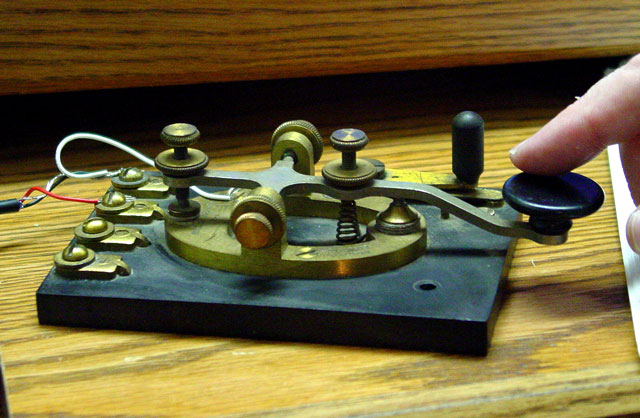 A
non-ham friend gave me this Western Electric Pole Changer Key A-2, which
I put to use during the American Radio Relay League's Straight Key Night, which
began at 0000 Zulu 1 Jan 2005 (6 pm CST 31 Dec 2004). My daughter, Megan, took
the photo as I made my first logged contact of 2005 with N5WLA of Azle,
Texas -- 347 miles away. Not a distance record, but not bad for 5 watts on 80
meters, considering band conditions. Straight keys are seldom used now, having
been replaced by paddles and electronic keyers. Nice, but lacking the sense of
history of the old keys. Can you imagine sending "What hath God
wrought!" with a plastic iambic paddle? I'm not sure how old this key is,
but I'd love to know when it was last used to send a message. Communication by
Morse code, by the way, will be 160 years old this May 24 -- the date on which
American painter Samuel Finley Breese Morse sent Numbers 23:23 from
Washington to Baltimore. One of the most common abbreviations in Morse code is
FB, for "Fine Business" -- and, perhaps not so coincidentally, the
middle initials of Morse himself. Click on the photo to go to the web page
of Locust Grove, the official Samuel F.B. Morse historic site.
A
non-ham friend gave me this Western Electric Pole Changer Key A-2, which
I put to use during the American Radio Relay League's Straight Key Night, which
began at 0000 Zulu 1 Jan 2005 (6 pm CST 31 Dec 2004). My daughter, Megan, took
the photo as I made my first logged contact of 2005 with N5WLA of Azle,
Texas -- 347 miles away. Not a distance record, but not bad for 5 watts on 80
meters, considering band conditions. Straight keys are seldom used now, having
been replaced by paddles and electronic keyers. Nice, but lacking the sense of
history of the old keys. Can you imagine sending "What hath God
wrought!" with a plastic iambic paddle? I'm not sure how old this key is,
but I'd love to know when it was last used to send a message. Communication by
Morse code, by the way, will be 160 years old this May 24 -- the date on which
American painter Samuel Finley Breese Morse sent Numbers 23:23 from
Washington to Baltimore. One of the most common abbreviations in Morse code is
FB, for "Fine Business" -- and, perhaps not so coincidentally, the
middle initials of Morse himself. Click on the photo to go to the web page
of Locust Grove, the official Samuel F.B. Morse historic site.
MICROCONTROLLER EXPERIMENT PROJECT
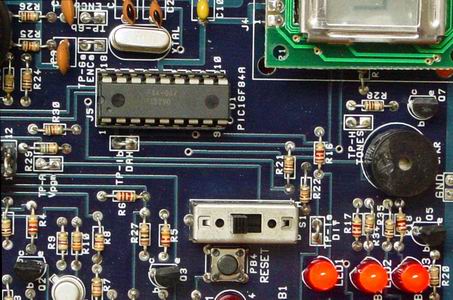 Detail
of the American QRP Club's PIC-EL experimenter's board. The programmable P16F84A microcontroller is at center left. At upper
right is the edge of the LCD display, below is the onboard speaker, and at
bottom are three of the board's four LEDs. Not shown are the encoder,
transmit and keyer ports, BNC jack, and RS-232 port. Although now retired, this
kit is the basis for the PIC Elmer 160 course on the AMQRP website.
Interested in learning more? Go here.
If you want to learn about microcontrollers, but don't care to build your own
programming board, you might want to check out the Basic STAMP 2 at Parallax.
Detail
of the American QRP Club's PIC-EL experimenter's board. The programmable P16F84A microcontroller is at center left. At upper
right is the edge of the LCD display, below is the onboard speaker, and at
bottom are three of the board's four LEDs. Not shown are the encoder,
transmit and keyer ports, BNC jack, and RS-232 port. Although now retired, this
kit is the basis for the PIC Elmer 160 course on the AMQRP website.
Interested in learning more? Go here.
If you want to learn about microcontrollers, but don't care to build your own
programming board, you might want to check out the Basic STAMP 2 at Parallax.
For a very cool micocontroller project, check out the Temple University Amateur Radio Station's Rover
ALDEN McDUFFIE QRP DUMMY LOAD
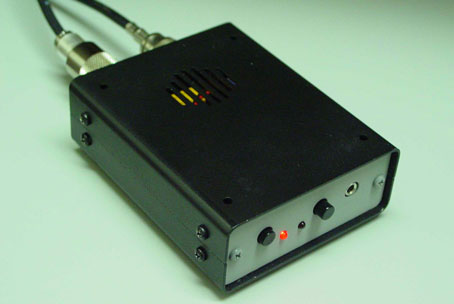 The
Alden McDuffie QRP
Smart Dummy Load kit went together nicely (about one hour assembly time) and
is a great companion for radios such as the Icom 703. It will handle amaximum of 10 watts, has a PIC controlled coaxial switch, and allows
you to leave the antenna attached. Power is consumed by a five three-watt resistors, providing a 50-Ohm load. It's powered by aninternal 9-volt battery, switched by relay, and has an LED that glows
in proportion to total power out. For more features, check the website. Like all AD kits, it is well-designed and has a very
professional aluminum case. The case comes unfinished; the
color scheme (black exterior, gray panels) was mine. For best results, be sure to prime the case before painting (that tip is courtesy of Joe,
W0MQY). I've found the AM SDL to be very handy. It's nice to be able to kick in the dummy load in order to adjust your code key for a moment
without having to change settings, or to check SWR between the rig (1:1 with
The
Alden McDuffie QRP
Smart Dummy Load kit went together nicely (about one hour assembly time) and
is a great companion for radios such as the Icom 703. It will handle amaximum of 10 watts, has a PIC controlled coaxial switch, and allows
you to leave the antenna attached. Power is consumed by a five three-watt resistors, providing a 50-Ohm load. It's powered by aninternal 9-volt battery, switched by relay, and has an LED that glows
in proportion to total power out. For more features, check the website. Like all AD kits, it is well-designed and has a very
professional aluminum case. The case comes unfinished; the
color scheme (black exterior, gray panels) was mine. For best results, be sure to prime the case before painting (that tip is courtesy of Joe,
W0MQY). I've found the AM SDL to be very handy. It's nice to be able to kick in the dummy load in order to adjust your code key for a moment
without having to change settings, or to check SWR between the rig (1:1 with 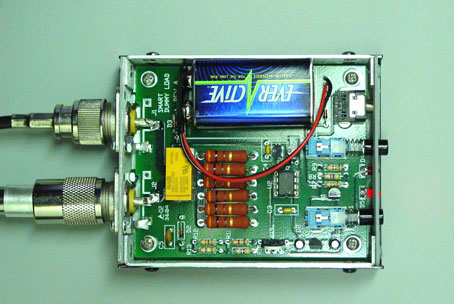 dummy load in) and the antenna. Also, the there's a
spot switch to key the 703 for use as a signal generator (turn the power down to 50 mw!) so your hands are free to work on a circuit. No key
necessary. The dummy load was designed by Phil Anderson, W0XI, who does great work.
It is $49.95 in kit form and $59.95 fully assembled. The manual for the dummy load are available for download on the Alden McDuffie
webite, www.aldenmcduffie.com. Also, three of Phil's Alden McDuffie kits are featured in the current issue
of QST: the CW filter, the dummy load, and a signal generator. Very impressive! By the way, Phil is scheduled to speak at
OzarkCon in April, and I'm sure I speak for the rest of the 4SQRP Group when I
say we're very lucky to have him.
dummy load in) and the antenna. Also, the there's a
spot switch to key the 703 for use as a signal generator (turn the power down to 50 mw!) so your hands are free to work on a circuit. No key
necessary. The dummy load was designed by Phil Anderson, W0XI, who does great work.
It is $49.95 in kit form and $59.95 fully assembled. The manual for the dummy load are available for download on the Alden McDuffie
webite, www.aldenmcduffie.com. Also, three of Phil's Alden McDuffie kits are featured in the current issue
of QST: the CW filter, the dummy load, and a signal generator. Very impressive! By the way, Phil is scheduled to speak at
OzarkCon in April, and I'm sure I speak for the rest of the 4SQRP Group when I
say we're very lucky to have him.
ALDEN McDUFFIE INC 500 Hz CW FILTER KIT
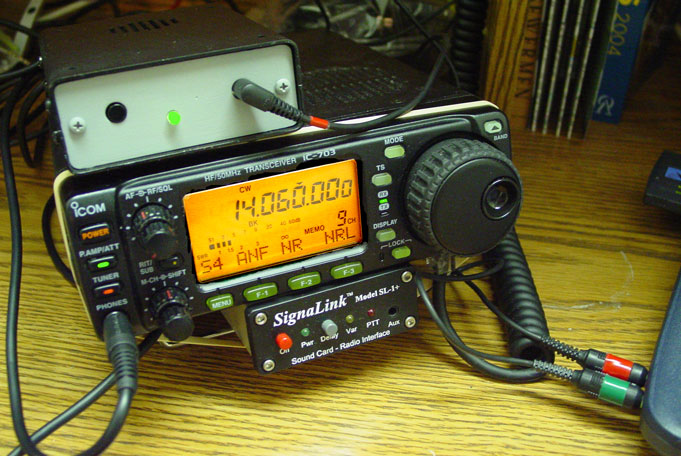 Here's my build of
the outboard CW filter
being offered by the QRP firm of Alden McDuffie Inc. of Lawrence, Kansas, and it works nicely with the 703. The filter was designed by
Phil Anderson WØXI, former owner of Kantronics, and he came up with the filter as an alternative to the pricey FL-52A ($145 to $169,
depending on vendor) Icom filter. Plus, this filter can be used with other rigs as
well. My filter differs
from the kit only in a few areas; instead of a red LED in the front panel,
I used a green one (there's no accounting for taste), I painted the enclosure
black and gray, and I added some rubber feet so
it wouldn't scuff the top of my 703 Plus. Other
than that, the kit is stock -- and was easy and a lot of fun to build. "The Alden Assistant 2 CW Filter was conceived within a few days of
bringing home a new IC-703 (from Dayton, 2004) and operating CW with it," Phil says on the site. "The 703 is a great little radio but mine
didn't come with a narrow CW filter. Expensive IF CW filters can be purchased from the rig maker or third parties but you have to
install them! I opted to save some money and have fun at the same time, so I designed and built the filter. I hope you'll enjoy
building and using it too." The cost is $59.95 for a fully assembled kit; $49.95 for a kit with
all components; and $19.95 for the PCB only. It runs on a 9-volt battery or a
13.8-volt bench supply. A very nice aluminum enclosure is
an
Here's my build of
the outboard CW filter
being offered by the QRP firm of Alden McDuffie Inc. of Lawrence, Kansas, and it works nicely with the 703. The filter was designed by
Phil Anderson WØXI, former owner of Kantronics, and he came up with the filter as an alternative to the pricey FL-52A ($145 to $169,
depending on vendor) Icom filter. Plus, this filter can be used with other rigs as
well. My filter differs
from the kit only in a few areas; instead of a red LED in the front panel,
I used a green one (there's no accounting for taste), I painted the enclosure
black and gray, and I added some rubber feet so
it wouldn't scuff the top of my 703 Plus. Other
than that, the kit is stock -- and was easy and a lot of fun to build. "The Alden Assistant 2 CW Filter was conceived within a few days of
bringing home a new IC-703 (from Dayton, 2004) and operating CW with it," Phil says on the site. "The 703 is a great little radio but mine
didn't come with a narrow CW filter. Expensive IF CW filters can be purchased from the rig maker or third parties but you have to
install them! I opted to save some money and have fun at the same time, so I designed and built the filter. I hope you'll enjoy
building and using it too." The cost is $59.95 for a fully assembled kit; $49.95 for a kit with
all components; and $19.95 for the PCB only. It runs on a 9-volt battery or a
13.8-volt bench supply. A very nice aluminum enclosure is
an 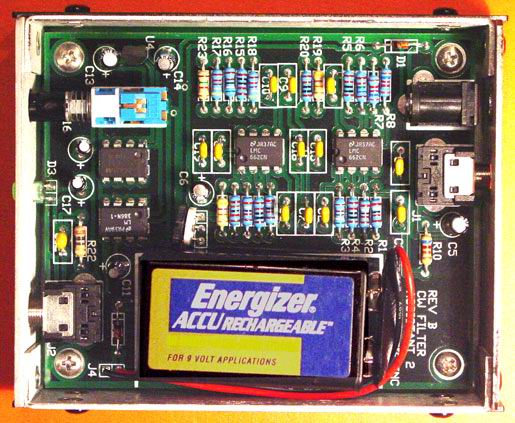 additional $12.95, but it is definitely worth it. For the
whole works, kit and enclosure, the cost is $62.90. Shipping is a flat $4.95
per order. The filter is 8-pole Chebyshev, 500 Hz bandwidth, centered at 750
Hz.. The battery draws just 10 ma with no signal, ~ 12 ma with average signal. It
attaches to radio speaker "phones" output on the 703 (or other radios), and feeds an external 8-ohm speaker or mono headphones. It took me only about an hour to
build my kit, and the instructions and
support are excellent. For more information, you can go to the Alden
McDuffie Inc website.
additional $12.95, but it is definitely worth it. For the
whole works, kit and enclosure, the cost is $62.90. Shipping is a flat $4.95
per order. The filter is 8-pole Chebyshev, 500 Hz bandwidth, centered at 750
Hz.. The battery draws just 10 ma with no signal, ~ 12 ma with average signal. It
attaches to radio speaker "phones" output on the 703 (or other radios), and feeds an external 8-ohm speaker or mono headphones. It took me only about an hour to
build my kit, and the instructions and
support are excellent. For more information, you can go to the Alden
McDuffie Inc website.
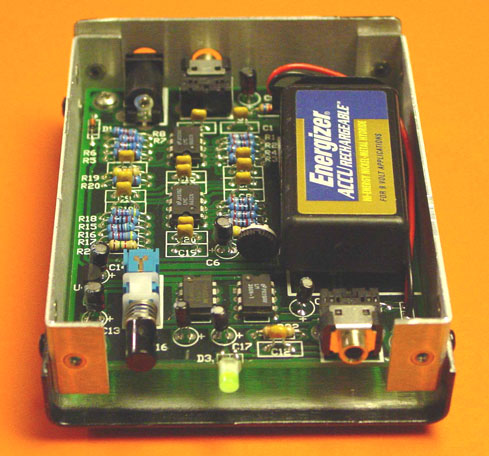
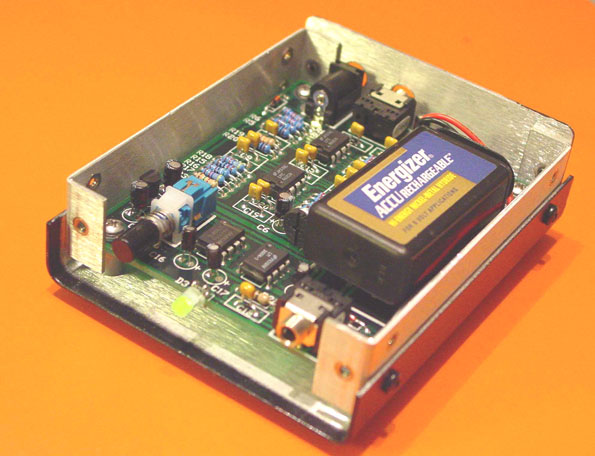
Spectran Captures of the Alden McDuffie filter performance (click to enlarge). Left, without filter; Right, with filter.
DIGITAL POWER AND SWR METER
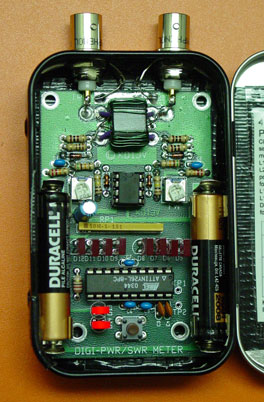
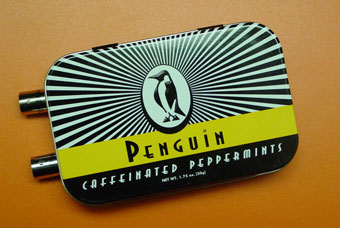 The
Four State QRP Group Digital Power and SWR Meter. A great project designed by Steve Weber KD1JV,
this meter works from 160 to 6 meters. It measures power from 20 milliwatts to
9.9 to 10 watts (in two scales), has a PEP hold
setting for measuring SSB output, and measures VSWR from 1:1 to 9.9:1. The
readout is a two-digit BDC encoded display. It's a great tool for
field QRP work -- and is self-containted in a standard Altoids (or, in this case,
Penguin) tin. To conserve batteries, it turns itself off after a few minutes
inoperation.
The price? An incredible $26. Unfortunately, these sold out quickly in Summer 2004. As
of October, however, the group still has plenty of KD1JV Tenna
Dipper kits for sale.
The
Four State QRP Group Digital Power and SWR Meter. A great project designed by Steve Weber KD1JV,
this meter works from 160 to 6 meters. It measures power from 20 milliwatts to
9.9 to 10 watts (in two scales), has a PEP hold
setting for measuring SSB output, and measures VSWR from 1:1 to 9.9:1. The
readout is a two-digit BDC encoded display. It's a great tool for
field QRP work -- and is self-containted in a standard Altoids (or, in this case,
Penguin) tin. To conserve batteries, it turns itself off after a few minutes
inoperation.
The price? An incredible $26. Unfortunately, these sold out quickly in Summer 2004. As
of October, however, the group still has plenty of KD1JV Tenna
Dipper kits for sale.
ROCK MITE 40 NOVICE
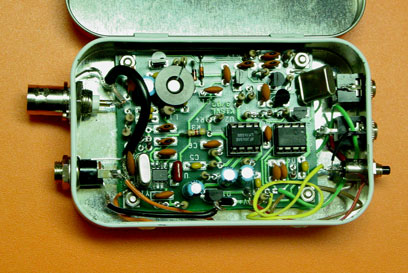
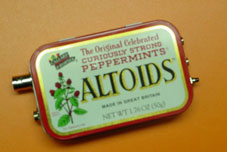 Here's
the Small Wonder Labs Rock Mite in 40 meter Novice, which puts about half
a watt on 7.121 MHz. Another great (and inexpensive) kit from Dave Benson at SWL,
and one that makes a great project for first-time builders. It
features on-board keyer, and the paddle and phone jacks are at right, with
the menu PB (to change offset and adjust sending speed) beneath. For more kits,
go to Small Wonder Labs.
Here's
the Small Wonder Labs Rock Mite in 40 meter Novice, which puts about half
a watt on 7.121 MHz. Another great (and inexpensive) kit from Dave Benson at SWL,
and one that makes a great project for first-time builders. It
features on-board keyer, and the paddle and phone jacks are at right, with
the menu PB (to change offset and adjust sending speed) beneath. For more kits,
go to Small Wonder Labs.
SMALL WONDER LABS DSW-II 20
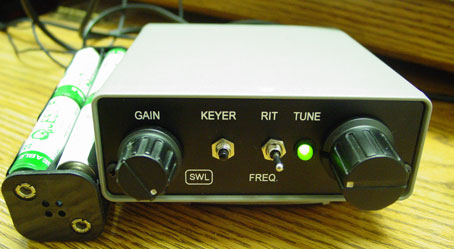 Here's
the DSW-II 20 from Small Wonder Labs. Although more complicated to build
than the Rock Mite, it has features that compare with rigs costing many times
more. This one puts out 4 watts and tunes the entire 20 meter CW band, and
powers up at 14.060 MHz -- the traditional QRP calling frequency. It also has
RIT and a Morse frequency readout. This is a terrific backpacking radio
and the RX compares well commercial rigs. Many thanks to KD1JV for helping
troubleshoot building mistakes on my rig.
Here's
the DSW-II 20 from Small Wonder Labs. Although more complicated to build
than the Rock Mite, it has features that compare with rigs costing many times
more. This one puts out 4 watts and tunes the entire 20 meter CW band, and
powers up at 14.060 MHz -- the traditional QRP calling frequency. It also has
RIT and a Morse frequency readout. This is a terrific backpacking radio
and the RX compares well commercial rigs. Many thanks to KD1JV for helping
troubleshoot building mistakes on my rig.
QRP COMMERCIAL RIG
ICOM 703 PLUS
A great QRP rig (5 watts on battery pack, 10 watts on 13.8 volt supply) and little brother to the famous Icom 706. Transmit from 160 to 6 meters. It will also receive down to 30 kHz, which makes it good for capturing those elusive LowFer beacons. Works great from a backpack or picnic table with a dipole or PAC 12 antenna, mine is in daily use as a base rig with a G5RV. Longest QSO so far is Spain on PSK31. Also pictured is the Arizona ScQRPion paddle. The ScQRPions kitted about 900 of these paddles in the past few months, and have knocked off production for the summer to get some much-needed rest. They will be offered again this fall, I understand. The ScQRPion paddle site is here.
OTHER RADIOS
ICOM V8000 2 METER
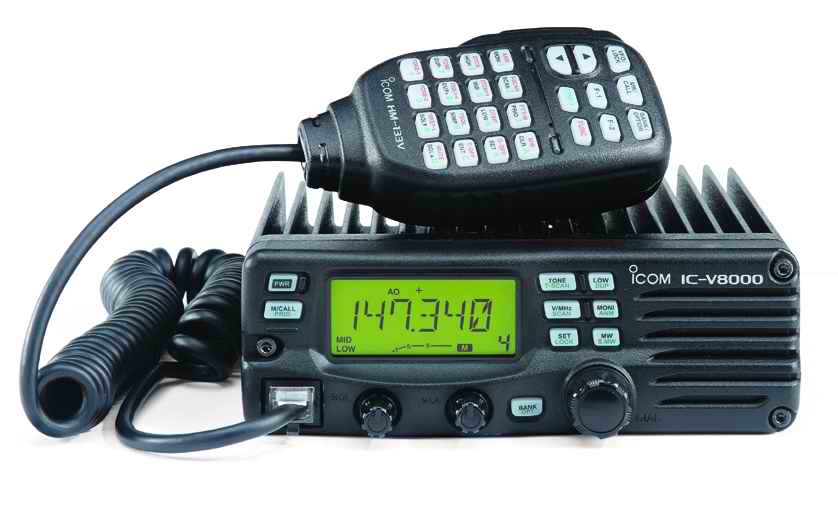 ICOM
V8000 75W mobile wide receive 2 meter (left). Two-meter
rigs are a must-have for amateur radio operators, and this is a new rig from
Icom that puts out from 5 to 75 watts. First used it as a base, but is now installed in a heavy-duty overhead console
in my 2003 Jeep Wrangler X. I especially like the wide receive, the WX alert, 200 memory channels, and the (mostly) intuitive programming.
ICOM
V8000 75W mobile wide receive 2 meter (left). Two-meter
rigs are a must-have for amateur radio operators, and this is a new rig from
Icom that puts out from 5 to 75 watts. First used it as a base, but is now installed in a heavy-duty overhead console
in my 2003 Jeep Wrangler X. I especially like the wide receive, the WX alert, 200 memory channels, and the (mostly) intuitive programming.
SWAN 270B HF TUBE RIG
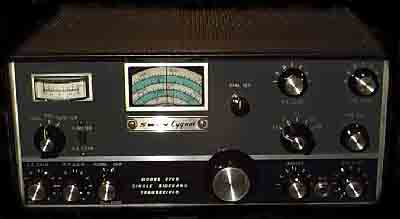
Swan HF Cygnet 270B Transceiver 1970 tube rig.
From the Swan Virtual Museum: "The Swan 270 transceiver and later the 270B, featured the same size and power as the 260, plus selectable sideband, a meter for tuning and S-meter, a sharper CF network, AGC, ALC, seperate AF and RF gain controls, a 100kz crystal calibrator, and a socket for an optional VOX unit. This unit sold for $525.00 US in 1969. The 270B was introduced in 1970, and is the same radio as the 270 except is only has the built-in 117 vac supply. The 14A dc supply was optional. ($39.95) Selling price in 1970 is listed at $499.00 US"
KCØMAX's HELP PAGES
The MP3 Code Practice Page
A collection of amateur radio and weird science stories at 13 and 20 wpm.
The WinMorse MP3 Conversion Page
WinMorse 2 is a great program; here's how to use it to convert the 8-bit WAV files to 16-bit files for MP3 conversion.
RADIO LINKS
The Xtal Set Society
Midnight Science "Crystal Sets? Yup, you’ve found an entire site about building Crystal Sets. The Society has been growing over the past 13 years as word gets out to enthusiasts. Still, some people are flabbergasted to find an entire society dedicated to Crystal Set radios (or "Xtal Sets"). One web surfer e-mailed, "I was so excited to find your site that I fell off my chair!" The Xtal Set Society publishes a newsletter and numerous books, all of which you can find more information about on this site." -- Rebecca, The Crystal Queen, Editor, Xtal Society News.
Short Wave Listening
Radio Intelligencer Not just another SWL site -- this is the best SWL site.
Lake Erie Boat Anchors Group (multimedia site)
Want to hear what a spark-gap transmission from the early days of radio sounded like? How about the Hallicrafters 45rpm recording, "The Amazing World of Shortwave Listening?" If so, take a look at the Boat Anchors.
The Prelinger Archive (multimedia site)
This Internet Archive is building a digital library of Internet sites and other cultural artifacts in digital form. Like a paper library, it provides free access to researchers, historians, scholars, and the general public. Although not a radio site per se, it has some great radio-related archival footage in the form of documentaries and training films from World War II. Go to the Moving Images section of the site and take a look at "Radio at War" or "Voice of Victory." The latter is an excellent documentary about Hallicrafters and how it adapted the HT-4 for combat use.
QRP Nets (all CW unless noted)
Tuesday Brass
Pounder -- Fall and winter at 9 pm Central (0300 UTC Wednesday) on or close to
3.562 MHz (please
note frequency change!). This is a "just for fun" roundtable net at whatever speed the operators are comfortable with. The net is primarily intended to help improve
CW skills. All QRPers are invited to check in, regardless of your proficiency. Shaky and rusty fists welcome!
Wednesday Warble PSK Net -- 9:00 PM Central on or near 3580.5 kHz. All
QRPers invited to join the informal roundtable.
CW Net meets at 8 pm Central Wednesday (0200 UTC Thursday) on or around 3.710 MHz (7.112 summer). All stations are welcome and you are encouraged to join in, whether you are a member or not. The NCS will accommodate your code speed. Check in (QNI) at the speed you can copy, and the NCS will come back at the same speed.
The Georgia Training Net (GTN) meets daily at 9 pm Eastern (0200 UTC) on 3.702 MHz. The GTN is a Morse code training net and meets to train traffic handlers and to pass traffic as part of the ARRL National Traffic System. The net offers training in Basic, Advanced, NCS, Liaison and Instructor training. For more information contact the Net Manager Bill Carter, KG4FXG.
Arkansas QRP Club, Monday, 7:30
pm Central, 3.560
MHz.
BC Group (SSB), Daily, 0300/0530 UTC, 3.729 MHz.
Knightlights, Sunday, 9 pm Eastern, 3.686 MHz.
Michigan QRP Club, Tuesday, 9 pm Eastern, 3.535 MHz.
New England QRP Club (SSB), Tuesday, 7:30 pm Eastern, 7.288 MHz.
New England QRP Club, Thursday, 8:30 pm Eastern, 3.565 MHz.
NoGaQRP, Tuesday, 9:30 pm, 3.686 MHz.
South Dakota Net, Wednesday, 90 pm Central, 3.700 MHz.
Elecraft CW Net
-- Sunday, 2300 UTC, 14.050 MHz; Mondays, 0200, 7045 kHz.
Icom SSB Net -- Sunday, 1700 UTC, 14.317 MHz.
Ten-Tec SSB Users Net -- Sunday, 2300 UTC, 14.267 MHz.
Organizations
Federal Communications Commission
International Amateur Radio Union
International Telecommunication Union
Amateur Clubs
(JARC) Joplin Amateur Radio Club
Northwest Arkansas Amateur Radio Club
Ozark
Wireless Society
Parsons Area Amateur Radio Club Home Page
Pittsburg Repeater Group Homepage
Pittsburg Repeater Organization Homepage
(SMARC) Southwest Missouri ARC
QRP Clubs
Alaska QRP Club
American
QRP Club
Eastern PA QRP Club
Flying
Pigs QRP Club
HF Pack (check out their antenna shootout results)
Minnesota QRP Society
New England QRP Club
New
Jersey QRP Club
NorCal -- Northern California QRP Club
QRP
Amateur Radio Club International
QRP-L
Reflector Mailing List
Southeast Ohio Radio Adventure Team
Virginia QRP Society
W5JH (associated with Arizona ScQRPions)
Have a club you'd like listed? Please email.
QRP Kit / Commercial Rig Manufacturers
K8ZT's Online Spreadsheet of Rigs and Features
Wilderness Radio (aka QRP Bob)
QRP Online Groups

QRP personal web pages
Useful Links
NASA Satellite Tracking Web Page
NTE Numeric Semiconductor Specifications
QRZ callsign lookup and website
QRP Books and Articles
ARRL: QRP Basics by George Dobbs G3RJV
ARRL "Kits, Homebrew, and other QRP Projects" (a great primer on tools needed) by K8ZT
ARRL: Low Power Communications by Rich Arland, K7SZ
ARRL: "The QRP Community" by by Anthony A. Luscre, K8ZT
ARRL: QRP Power. QRP-related articles from QST, QEX and the ARRL Handbook
ARRL QRP Projects (web bibliography)
ARRL: QRP: "What, Why, and How?"
ARRL: "Shopping (hamfests) for QRP Items and Supplies" by Anthony A. Luscre K8ZT.
ARRL: W1FB's QRP Notebook by Doug DeMaw.
The Joy of QRP by Adrian Weiss WØRSP
"What Kit to Build" by Doug Hendricks KI6DS
Square 1 Electronics / David Benson PIC books
Contact
or write:
KCØMAX
POB 1607
Pittsburg, KS 66762
Click on Photo to go to the
WEIRD RADIO FILES
About the moon photo at top of page: Photo by KCØMAX 13 Jan 2005 through WØMQY's 10-inch telescope using a Canon EOS 10d digital camera. The camera was hand-held over the eyepiece. Thanks, Joe!
|
This QRP Web Ring site owned by Max McCoy . Previous 10 | Skip prev | Previous | Next | Skip next | Next 10 Random Site | List Sites | Join QRP Web Ring |
Back to the top of KCØMAX's Amateur Radio Home Page
Go to KCØMAX's Weird Radio Files
To Author Max McCoy's home page